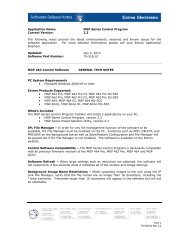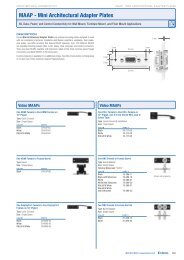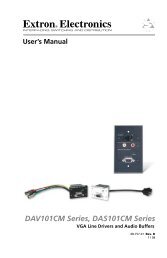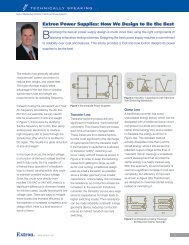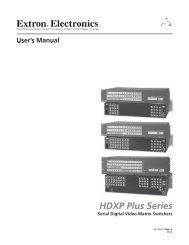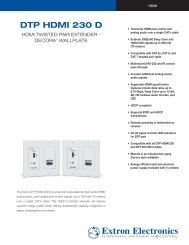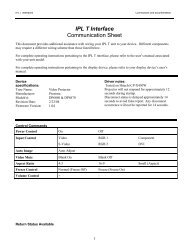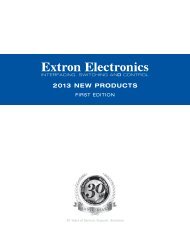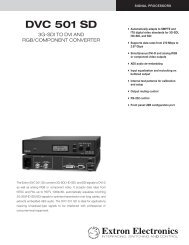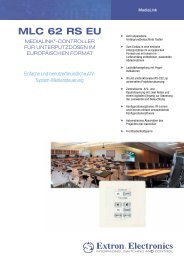Ethernet Configuration and Control, cont'd - Extron Electronics
Ethernet Configuration and Control, cont'd - Extron Electronics
Ethernet Configuration and Control, cont'd - Extron Electronics
You also want an ePaper? Increase the reach of your titles
YUMPU automatically turns print PDFs into web optimized ePapers that Google loves.
The error response codes <strong>and</strong> their descriptions are as follows:<br />
E12 – Invalid port number<br />
E13 – Invalid value (the number is out of range/too large)<br />
E14 – Not valid for this configuration<br />
E17 – System has timed out.<br />
E22 – Busy<br />
E24 – Privilege violation<br />
E25 – Device is not present.<br />
E26 – Maximum number of connections has been exceeded.<br />
E27 – Invalid event number<br />
E28 – Bad filename or file not found<br />
E30 – Hardware failure (followed by a colon [:] <strong>and</strong> a descriptor number)<br />
E31 – Attempt to break port pass-through when it was not set<br />
Error response references<br />
The following superscripted numbers are used within the comm<strong>and</strong> descriptions<br />
on the following pages to identify comm<strong>and</strong>s that may respond as shown:<br />
14 = comm<strong>and</strong>s that give an E14 (invalid comm<strong>and</strong> for this configuration)<br />
response if sent to an IPL product whose current configuration does not<br />
support the comm<strong>and</strong>.<br />
24 = comm<strong>and</strong>s that give an E24 (privilege violation) response if you are not<br />
logged in at the administrator level.<br />
27 = comm<strong>and</strong>s that may yield an E27 (invalid event number) response.<br />
28 = comm<strong>and</strong>s that may give an E28 (file not found) response.<br />
Using the Comm<strong>and</strong>/Response Table<br />
The PC1 can be controlled via either a Telnet (port 23) connection or a Web browser<br />
(port 80) connection. The ASCII <strong>and</strong> URL comm<strong>and</strong>s listed in the tables starting on<br />
page 5-8 perform the same functions, but they are encoded differently to<br />
accommodate the requirements of each port (Telnet or Web).<br />
The ASCII to hexadecimal (HEX) conversion table below is for use with the<br />
comm<strong>and</strong>/response tables.<br />
ASCII to HEX Conversion Table<br />
•<br />
The comm<strong>and</strong>/response tables list valid ASCII (for Telnet) comm<strong>and</strong> codes, the<br />
corresponding URL (universal resource locator) encoded (for Web browsers)<br />
comm<strong>and</strong> codes, the interface’s responses to the host, <strong>and</strong> a description of the<br />
comm<strong>and</strong>’s function or the results of executing the comm<strong>and</strong>.<br />
Upper- <strong>and</strong> lowercase characters may be used interchangeably in the<br />
comm<strong>and</strong> fields unless otherwise specified.<br />
Comm<strong>and</strong>s may be sent back-to-back without spaces (for example, 2!65V1Z).<br />
IPL T PC1 SIS Programming <strong>and</strong> <strong>Control</strong><br />
5-3<br />
PRELIMINARY



